From Duct Tape to Dark Energy: Shank’s Directorship Continues: Unexpected Discoveries in Times of Tumult

Science announces Accelerating Universe is Breakthrough of the Year.
By the mid-1990s the United States was a nation of ironic extremes. Wealth and waste coexisted with homelessness and illiteracy. Terror and violence threatened at home and abroad, from Columbine to the World Trade Center to the Middle East. The burgeoning internet brought spam and scam along with knowledge and communication; the dot-com economy was as flimsy as it was grandiose. We were addicted to oil, we were desperate for energy efficiency, and we were changing the climate — we knew all that, or at least we had good evidence for it, but meanwhile we flew to the ends of the Earth on adventure travels and bought gas-guzzling SUVs as readily as we bought cell phones.
Charles Shank kept a firm hand on Berkeley Lab’s tiller through these increasingly tumultuous times; a network of connections with far-flung, cutting-edge science programs and Shank’s familiarity with the ins and outs of Washington played a major role in keeping the Lab on a steady course.
The Lab’s research heading into the new century was just as eclectic and surprising as the era. The year 1998, to pick one example, brought wide media attention from two wildly different discoveries. One, that the expansion of the universe is not slowing as expected but accelerating, was named Science magazine’s “Breakthrough of the Year.” The other, that duct tape is good for anything except sealing ducts, won rather different kudos, including a raucous review by Tom and Ray Magliozzi on NPR’s “Car Talk.”
In Service to Society

Researchers launching Carbon Explorer floats in the Pacific Ocean.
These seemingly asymmetric discoveries were indications, among many others, of the major trends in science and society directly fueled by Berkeley Lab research. Take duct tape: replacing it with a sealant that works, like the Aeroseal system developed in the Environmental Energy Technologies Division, saves home and building heating energy and dollars. A raft of other advances in energy efficiency included cool roofs, windows that can alter reflectivity, and economical (and safe) lighting systems like the cool fluorescent torchiere and the Berkeley Lamp.
EETD director Mark Levine was early to recognize the energy implications of China’s rapidly growing economy; he forged ties with the government of China, at first concentrating on Chinese refrigerators, the largest refrigerator economy in the world. Berkeley Lab’s China Energy Group signed agreements in 1999 that have grown into a vital role in advising China’s energy policy.
Sally Benson, Earth Sciences Division director in the mid-90s, led a broad effort to understand the carbon cycle and to find ways of sequestering excess carbon pumped into the atmosphere. By early 2004 the first tests of geological carbon sequestration were scheduled for deep brine aquifers in Texas, aided by an increasingly sophisticated family of simulation codes, called TOUGH, for simulating fluid and heat flow in porous and fractured underground media like depleted oil and gas reservoirs.
Terrestrial carbon studies pointed to the danger from fires, hurricanes, and flooding as the global temperature increased. Jim Bishop’s Carbon Explorer floats monitored and reported on particulate carbon in the upper ocean, leading to breakthroughs in understanding how plankton absorbs carbon from the atmosphere even in the inhospitable reaches of the Northern Pacific and the Southern Ocean.
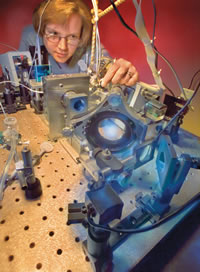
Carlos Bustamante’s Optical Tweezers.
Mina Bissell and Joe Gray, her successor as director of the Life Sciences Division, used new biological knowledge to deepen understanding of what was becoming known as “systems biology.” The Joint Genome Institute, a consortium of DOE national laboratories Lawrence Berkeley, Lawrence Livermore, and Los Alamos, opened for business in December, 1997, and an accelerating flow of genome data stimulated emphasis on systems biology and its close relative, quantitative biology. Early in 2001, working drafts of the human genome were published in Science and Nature; the JGI contributed sequences of human chromosomes 5, 16, and 19.
With the aid of faster computers and more advanced algorithms, studies of gene regulation intensified. Rapid sequencing renewed interest in proteins, including how they are structured and how they work, whether alone or together as “machines” to perform the business of the cell and organism. X-ray crystallography at the Advanced Light Source plus a range of microscopic techniques revealed structures for the ribosome and other important protein machines and individual proteins at the highest resolutions ever.

Protein Crystallography at the Advanced Light Source.
Scientific computation played an ever more important role in research under the direction of Bill McCurdy and Horst Simon. NERSC helped rewrite the equations of turbulence (disproving the “Law of the Wall”), find the first solution to the three-charged-particle problem in quantum chemistry, investigate the intricate electronic pathways of photosynthesis, model and visualize gas flames and particle accelerators and the world’s climate — from local neighborhoods to continents, oceans, and the whole globe — and even model the interior of the earth, the shapes of exploding stars, and how black holes collide.
Almost as remarkable as these supercomputer feats was an algorithm cooked up by David Bailey and his colleagues that could find any binary digit of pi in a few seconds with a desktop PC; it was named one of the top 10 “algorithms of the century.”
NERSC was a contender in the computing power sweepstakes throughout the 1990s. The IBM machine named “Seaborg,” in honor of the Lab’s great chemist who had died in February, 1999, was the most powerful unclassified supercomputer in the world at the beginning of the new century. But a year later Japan’s custom-made giant Earth Simulator jumped ahead of general-purpose machines — forcing U.S. computing scientists, with a Berkeley Lab team involved in leading the effort, to rethink the nature of scientific computing.
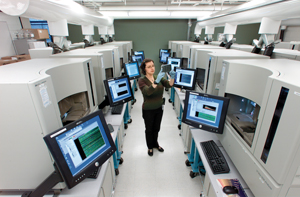
Sequencers at the Joint Genome Institute.
During the Shank years the Lab also led in computing connectivity. Lab-led teams achieved victory after victory in High-Performance Band-width Challenges at supercomputing conferences, moving ever-larger amounts of data in record time. The Lab was the home of ESnet, managing the high-speed data communications network that connected scientists and collaborators worldwide with DOE research and computing facilities. The Lab’s Van Jacobson was co-creator of Multicast Backbone, or MBone, the technology that made live internet videocasting practical; mileposts included hosting a Rolling Stones concert in 1994 and hooking up to the Antarctic research station in 1998.
In the Antarctic winter of 1999, subsequent computer connections by Berkeley Lab personnel helped establish live medical consultation with a woman doctor who had discovered a lump in her breast, at a time when the research station was so isolated planes could not land or take off in the subfreezing darkness.
From Science Fiction to Science

Saul Perlmutter, Supernova Cosmology Project.
Two fields of study gained special prominence during the latter half of Charles Shank’s directorship. In the early 1990s one of them, nanoscience, was more science fiction than science. The other, dark energy, couldn’t be found even in fiction.
But by the late 1990s nanoscience was real, aided at Berkeley Lab by tools like an electron-beam nanowriter, atomic-force microscopes, scanning tunneling microscopes, photo-emission electron microscopes at the ALS and record-breaking microscopes at the National Center for Electron Microscopy, able to pick out atoms as small as lithium next to heavy atoms in compound crystal lattices.
Soon to come were the nanorods, nanotetrapods and nanoarrowheads of Paul Alivisatos, who would later combine nanostructures and polymers into semiconducting hybrid solar cells. Alex Zettl led the development of telescoping nanotubes, nanotubes loaded with buckyball BBs, a new kind of buckyball, C-36, and the world’s tiniest motors. Discoveries like these on the materials sciences side, “from the atom up,” rapidly merged with new biological techniques, “from the microbe down.”
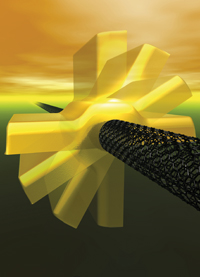
The synthetic rotational nanomotor, measuring between 100 and 300 nano-meters in length.
Novel techniques for studying and manipulating cells ranged from optical tweezers to nanocrystal tracers to cell engineering. From Carolyn Bertozzi’s research on living cells that grew artificial components on their surfaces, it was a short step to synthetic biology. Graham Fleming, then director of the Physical Biosciences Division, founded the nation’s first Synthetic Biology Department in 2003.
Meanwhile Shank championed the Molecular Foundry, proposed in 2001 by Daniel Chemla, then director of both the Materials Sciences and ALS divisions, who intended “to change the paradigm for nanoscale materials research.” Dedicated in March 2006, the Foundry is the first of five proposed DOE nano-science research centers and the only one on the West Coast.
Research, to borrow Jorge Luis Borges’s memorable phrase, is a garden of forking paths. Neutrino oscillation, made possible by neutrino mass, was confirmed by SNO in 2001, an “expected surprise.” But no fork in the physics path was more unexpected than the discovery of dark energy.
Beginning in the late 1980s the Supernova Cosmology Project, based at Berkeley Lab and led by Saul Perlmutter, pioneered methods of finding enough exceedingly bright, remarkably uniform, very far-off Type Ia supernovae to measure changes in the expansion of the universe. By 1994 the SCP had proved it could find dozens of distant Type Ia supernovae “on demand,” a hard-won feat that encouraged others to use similar methods to measure expansion with supernovae.
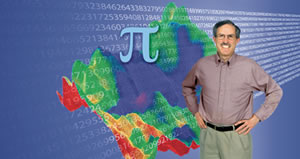
David Bailey, with the digits of pi.
Even the Berkeley Lab group expected to confirm that expansion was slowing. An article in the Lab’s Research Review in the fall of 1997 noted that “the Supernova Cosmology Project is measuring the universe’s deceleration … The preliminary results are in and they indicate that the universe appears to be slowing down.”
Whoops.
In January 1998 the SCP, and shortly thereafter the rival High-Z Supernova Search Team, announced a startling discovery: expansion is accelerating. The mutual gravitational attraction of all the matter in the universe, visible and dark, is insufficient to overcome the negative pressure of a mysterious, invisible something that accounts for three-quarters of the density of the universe — something soon to be called dark energy, “the most fundamentally mysterious thing in basic science” and “the biggest embarrassment in theoretical physics,” according to leading cosmologists.
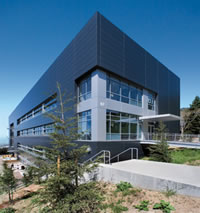
The Molecular Foundry.
In 1999 Perlmutter and his colleagues proposed a SuperNova/ Acceleration Probe, SNAP, to fly a two-meter telescope and a billion-pixel imager using Berkeley Lab’s robust, radiation-resistant, and uniquely red-sensitive astronomical CCD, descended from high-energy particle detectors. The SNAP concept was embraced by DOE (as “nonaccelerator physics”) and soon attracted the attention of NASA. In October 2003 the two agencies joined to mount a competitive Joint Dark Energy Mission, for which SNAP was the inspiration and, while constantly evolving, is still the leading contender.
“The world that we look at is a dynamic world, with movement and a lot of changing events,” said Shank in one of his last state-of-the-lab messages. “Change is true not only of science but of how we view the history of science as time passes.”
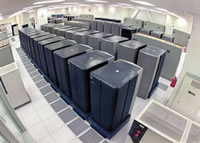
The IBM Seaborg Cluster at NERSC OSF.
Of the many discoveries made at the Lab during Shank’s long tenure, it is impossible to know which of those listed in this near contemporaneous summary — and a great many more that couldn’t be squeezed into the available space — will still seem significant even a decade from now, and which of those not mentioned will emerge as more important. Judgment will have to wait until Berkeley Lab celebrates its 100th anniversary.